Interaction between Hhex and SOX13 modulates Wnt/TCF activity
- PMID: 20028982
- PMCID: PMC2820800
- DOI: 10.1074/jbc.M109.046649
Interaction between Hhex and SOX13 modulates Wnt/TCF activity
Abstract
Fine-tuning of the Wnt/TCF pathway is crucial for multiple embryological processes, including liver development. Here we describe how the interaction between Hhex (hematopoietically expressed homeobox) and SOX13 (SRY-related high mobility group box transcription factor 13), modulates Wnt/TCF pathway activity. Hhex is a homeodomain factor expressed in multiple endoderm-derived tissues, like the liver, where it is essential for proper development. The pleiotropic expression of Hhex during embryonic development and its dual role as a transcriptional repressor and activator suggest the presence of different tissue-specific partners capable of modulating its activity and function. While searching for developmentally regulated Hhex partners, we set up a yeast two-hybrid screening using an E9.5-10.5 mouse embryo library and the N-terminal domain of Hhex as bait. Among the putative protein interactors, we selected SOX13 for further characterization. We found that SOX13 interacts directly with full-length Hhex, and we delineated the interaction domains within the two proteins. SOX13 is known to repress Wnt/TCF signaling by interacting with TCF1. We show that Hhex is able to block the SOX13-dependent repression of Wnt/TCF activity by displacing SOX13 from the SOX13 x TCF1 complex. Moreover, Hhex de-repressed the Wnt/TCF pathway in the ventral foregut endoderm of cultured mouse embryos electroporated with a SOX13-expressing plasmid. We conclude that the interaction between Hhex and SOX13 may contribute to control Wnt/TCF signaling in the early embryo.
Figures

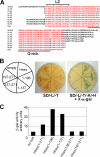
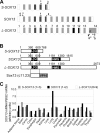
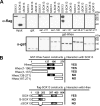



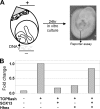

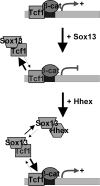
Similar articles
-
Sex-determining Region Y-box transcription factor 13 promotes breast cancer cell proliferation and glycolysis by activating the tripartite motif containing 11-mediated Wnt/β-catenin signaling pathway.Bioengineered. 2022 May;13(5):13033-13044. doi: 10.1080/21655979.2022.2073127. Bioengineered. 2022. PMID: 35611828 Free PMC article.
-
Expressions of Sox9, Sox5, and Sox13 transcription factors in mice testis during postnatal development.Mol Cell Biochem. 2015 Sep;407(1-2):209-21. doi: 10.1007/s11010-015-2470-7. Epub 2015 Jun 5. Mol Cell Biochem. 2015. PMID: 26045173
-
Sox13 functionally complements the related Sox5 and Sox6 as important developmental modulators in mouse spinal cord oligodendrocytes.J Neurochem. 2016 Jan;136(2):316-28. doi: 10.1111/jnc.13414. Epub 2015 Nov 25. J Neurochem. 2016. PMID: 26525805
-
The Yin-Yang of TCF/beta-catenin signaling.Adv Cancer Res. 2000;77:1-24. doi: 10.1016/s0065-230x(08)60783-6. Adv Cancer Res. 2000. PMID: 10549354 Review.
-
A WNTer revisit: new faces of β-catenin and TCFs in pluripotency.Sci Signal. 2011 Sep 27;4(193):pe41. doi: 10.1126/scisignal.2002436. Sci Signal. 2011. PMID: 21971038 Review.
Cited by
-
Growth-promoting and tumourigenic activity of c-Myc is suppressed by Hhex.Oncogene. 2015 Jun 4;34(23):3011-22. doi: 10.1038/onc.2014.240. Epub 2014 Sep 15. Oncogene. 2015. PMID: 25220416
-
Multi-label multi-instance transfer learning for simultaneous reconstruction and cross-talk modeling of multiple human signaling pathways.BMC Bioinformatics. 2015 Dec 30;16:417. doi: 10.1186/s12859-015-0841-4. BMC Bioinformatics. 2015. PMID: 26718335 Free PMC article.
-
SOX13 gene downregulation in peripheral blood mononuclear cells of patients with Klinefelter syndrome.Asian J Androl. 2021 Mar-Apr;23(2):157-162. doi: 10.4103/aja.aja_37_20. Asian J Androl. 2021. PMID: 33109779 Free PMC article.
-
Identification of Estrogen Signaling in a Prioritization Study of Intraocular Pressure-Associated Genes.Int J Mol Sci. 2021 Sep 24;22(19):10288. doi: 10.3390/ijms221910288. Int J Mol Sci. 2021. PMID: 34638643 Free PMC article.
-
STAT6, PBX2, and PBRM1 Emerge as Predicted Regulators of 452 Differentially Expressed Genes Associated With Puberty in Brahman Heifers.Front Genet. 2018 Mar 20;9:87. doi: 10.3389/fgene.2018.00087. eCollection 2018. Front Genet. 2018. PMID: 29616079 Free PMC article.
References
-
- McLin V. A., Rankin S. A., Zorn A. M. (2007) Development 134, 2207–2217 - PubMed
-
- Ober E. A., Verkade H., Field H. A., Stainier D. Y. (2006) Nature 442, 688–691 - PubMed
-
- Thomas P. Q., Brown A., Beddington R. S. (1998) Development 125, 85–94 - PubMed
-
- Bort R., Martinez-Barbera J. P., Beddington R. S., Zaret K. S. (2004) Development 131, 797–806 - PubMed
Publication types
MeSH terms
Substances
LinkOut - more resources
Full Text Sources
Molecular Biology Databases
Research Materials

